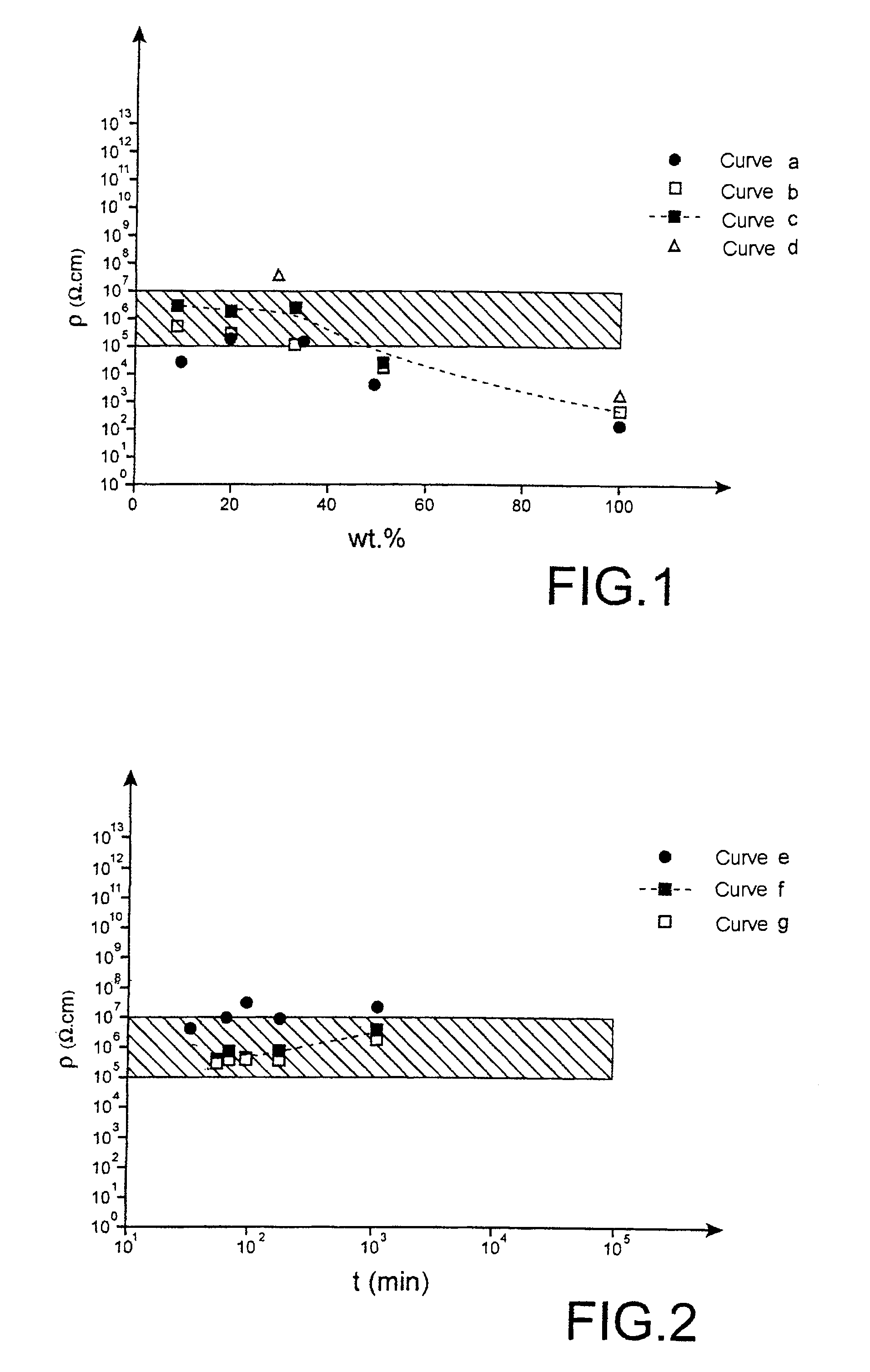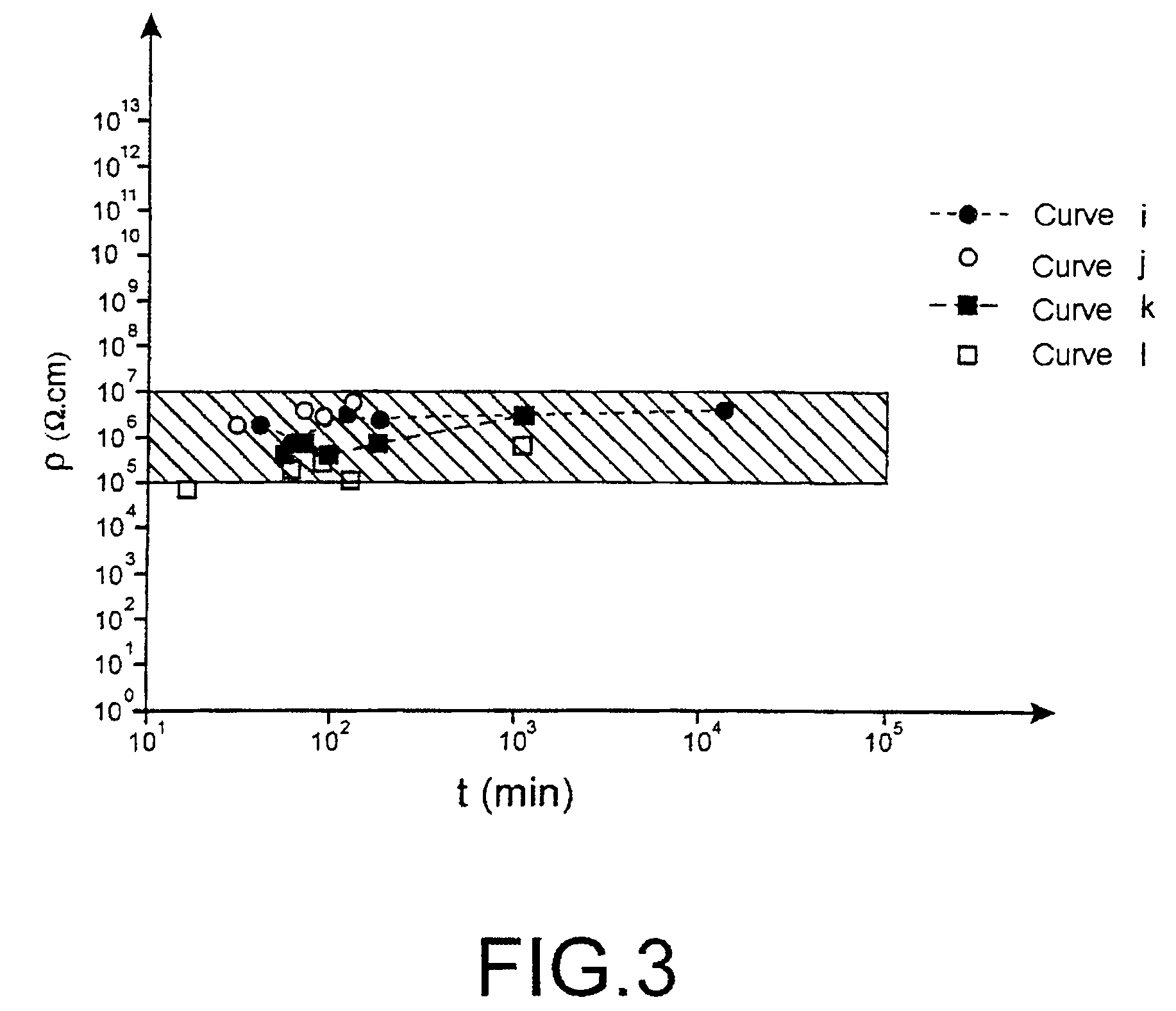Adhesive composite material with controlled resistivity
- Summary
- Abstract
- Description
- Claims
- Application Information
AI Technical Summary
Benefits of technology
Problems solved by technology
Method used
Image
Examples
example 1
[0085]In this example, the epoxy prepolymer was a mixture of BADGE (bisphenol A diglycidyl ether) and 1,4-butanediol diglycidyl ether and the crosslinking agent was an amine-BF3 complex (these ingredients being sold under the trade name EPOTEK OM 100). In this example, the electrically-conductive filler was an aniline tetramer supplied by Paniplast and the solvent was tetrahydrofuran (THF).
[0086]Table 2 below summarizes the nature of the compositions and also the crosslinking cycle which was applied to them.
%anilinetetramer +ConductivedopantTcrosslink.tcrosslink.ResinfillerSolvent(wt %)(° C.)(min)EpotekAnilineTHF8.6501440OM 100tetramer +19.82dopant33.2551.221008.6Tambient144019.8233.2551.2210029.73801140100
[0087]The content of doped aniline tetramer (aniline tetramer+dopant) was expressed as a percentage relative to the total weight (corresponding to the sum of the weight of resin and doped aniline tetramer).
[0088]FIG. 1 represents the resistivity ρ as a function of the content of d...
example 2
[0089]In this example, the epoxy prepolymer was a mixture of BADGE (bisphenol A diglycidyl ether) and 1,4-butanediol diglycidyl ether and the crosslinking agent was an amine-BF3 complex (these ingredients being sold under the trade name EPOTEK OM 100).
[0090]In this example, the electrically-conductive filler was an aniline tetramer supplied by Paniplast and the solvent was tetrahydrofuran (THF).
[0091]Starting from this mixture, various crosslinking cycles were imposed.
[0092]Table 3 below summarizes the nature of the compositions and also the crosslinking cycle which was applied to them.
% anilinetetramer +ConductivedopantTcrosslink.tcrosslink.ResinfillerSolvent(wt %)(° C.)(min)EpotekAnilineTHF30.125055OM 100tetramer +70dopant951781095803365951781095
[0093]The content of doped aniline tetramer (aniline tetramer+dopant) was expressed as a percentage relative to the total weight (corresponding to the sum of the weight of resin and doped aniline tetramer).
[0094]FIG. 2 represents the resis...
example 3
[0096]In this example, the epoxy prepolymer was a mixture of BADGE (bisphenol A diglycidyl ether) and 1,4-butanediol diglycidyl ether and the crosslinking agent was an amine-BF3 complex (these ingredients being sold under the trade name EPOTEK OM 100).
[0097]In this example, the electrically-conductive filler was an aniline tetramer supplied by Paniplast and the solvent was tetrahydrofuran (THF).
[0098]Two mixtures based on these ingredients were prepared.
[0099]Table 4 below summarizes the nature of the compositions and also the crosslinking cycle which was applied to them.
%anilinetetramer +ConductivedopantTcrosslink.tcrosslink.trestResinfillerSolvent(wt %)(° C.)(min)(min)EpotekAnilineTHF29.7350550OM 100tetramer +70dopant95178109537506089127107721.6850400601201801314030507090130
[0100]The content of doped aniline tetramer (aniline tetramer+dopant) was expressed as a percentage relative to the total weight (corresponding to the sum of the weight of resin and doped aniline tetramer).
[010...
PUM
| Property | Measurement | Unit |
|---|---|---|
| Temperature | aaaaa | aaaaa |
| Temperature | aaaaa | aaaaa |
| Percent by mass | aaaaa | aaaaa |
Abstract
Description
Claims
Application Information
 Login to View More
Login to View More - R&D
- Intellectual Property
- Life Sciences
- Materials
- Tech Scout
- Unparalleled Data Quality
- Higher Quality Content
- 60% Fewer Hallucinations
Browse by: Latest US Patents, China's latest patents, Technical Efficacy Thesaurus, Application Domain, Technology Topic, Popular Technical Reports.
© 2025 PatSnap. All rights reserved.Legal|Privacy policy|Modern Slavery Act Transparency Statement|Sitemap|About US| Contact US: help@patsnap.com



